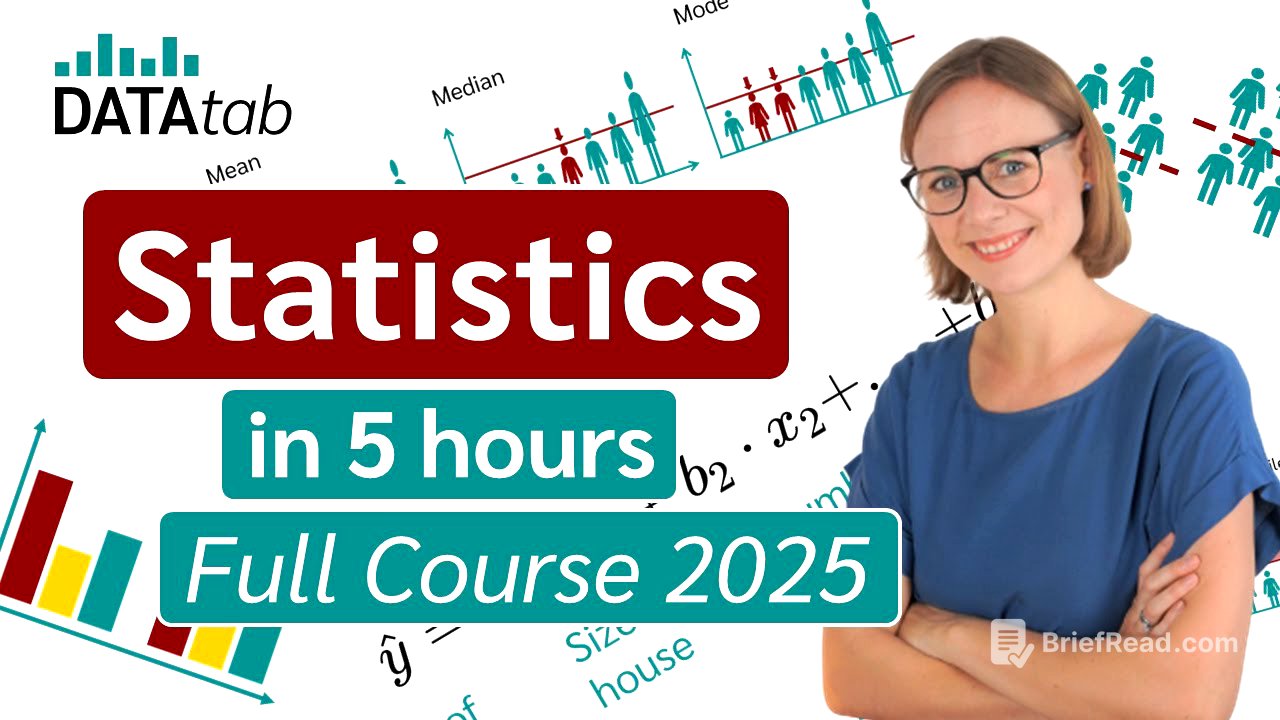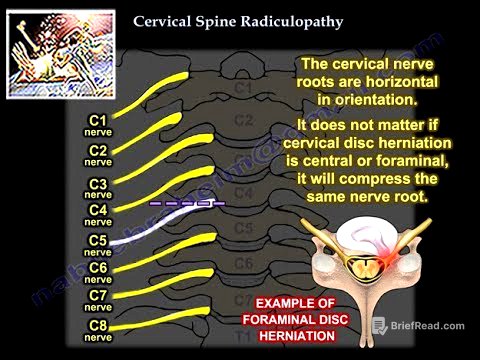TLDR;
Namaste everyone! This video is a comprehensive guide to statistics, covering everything from basic concepts to advanced statistical tests. It explains descriptive vs. inferential statistics, levels of measurement, hypothesis testing (t-tests, ANOVA), correlation and regression analysis, and cluster analysis. It also addresses parametric vs. non-parametric tests and how to check assumptions like normality and equal variances.
- Descriptive vs. Inferential Statistics
- Hypothesis Testing (t-test, ANOVA, non-parametric tests)
- Correlation and Regression Analysis
- Cluster Analysis
- Checking Assumptions (Normality, Equal Variances)
Intro [0:00]
The video is an updated version of a popular statistics course. It aims to guide viewers through fundamental statistical concepts and powerful tests used in research. The course covers descriptive statistics, hypothesis testing, correlation, regression, and cluster analysis. All topics are also available in book format, link in description.
Basics of Statistics [1:52]
Statistics involves collecting, analysing, and presenting data. Variables are key, like gender and newspaper preference in a survey. Data can come from surveys or experiments, such as drug trials. The goal is to either describe the sample data (descriptive statistics) or make inferences about the entire population (inferential statistics).
Descriptive statistics summarise data using measures of central tendency (mean, median, mode), dispersion (variance, standard deviation, range, IQR), frequency tables, and charts. Inferential statistics draw conclusions about a population based on a sample. This involves hypothesis testing, P-values, and statistical significance.
Level of Measurement [21:56]
Levels of measurement are nominal, ordinal, interval, and ratio. Nominal data (e.g., gender, types of animals) can be categorised but not ranked. Ordinal data (e.g., rankings, satisfaction ratings) can be categorised and ranked, but intervals aren't meaningful. Metric data (interval and ratio) have equal intervals, allowing for meaningful differences and sums. The level of measurement determines which statistical analyses and visualisations are appropriate.
t-Test [34:56]
A t-test analyses if there's a significant difference between the means of two groups. There are one-sample, independent samples, and paired samples t-tests. The one-sample t-test compares a sample mean to a known reference mean. The independent samples t-test compares the means of two independent groups. The paired samples t-test compares the means of two dependent groups (e.g., before and after measurements on the same subjects). T-tests require metric data that is normally distributed.
ANOVA (Analysis of Variance) [51:18]
ANOVA tests whether there are statistically significant differences between the means of three or more groups. It's an extension of the t-test. The null hypothesis is that the means of all groups are equal. ANOVA uses the ratio of variance between groups to variance within groups to calculate an F-value. A post-hoc test identifies which specific groups differ significantly.
Two-Way ANOVA [1:05:36]
Two-way ANOVA tests the effect of two categorical variables (factors) on a continuous variable. It can determine if each factor has a main effect and if there's an interaction effect between the factors. Assumptions include normality, homogeneity of variances, and independence of measurements.
Repeated Measures ANOVA [1:21:51]
Repeated measures ANOVA tests whether there's a statistically significant difference between three or more dependent samples, where the same participants are measured multiple times. Assumptions include normality and sphericity (equal variances of the differences between all combinations of factor levels).
Mixed-Model ANOVA [1:36:22]
Mixed-model ANOVA is used when there are both between-subject factors (different subjects in different groups) and within-subject factors (same subjects measured multiple times). It tests for main effects of each factor and interaction effects.
Parametric and non parametric tests [1:48:04]
Parametric tests (e.g., t-test, ANOVA) assume data is normally distributed. Non-parametric tests (e.g., Mann-Whitney U test, Spearman's correlation) are used when data isn't normally distributed. Parametric tests are generally more powerful, but non-parametric tests make fewer assumptions.
Test for normality [1:55:49]
Normality can be tested analytically (Kolmogorov-Smirnov, Shapiro-Wilk, Anderson-Darling tests) or graphically (histogram, QQ plot). Analytical tests provide a P-value; a P-value less than 0.05 suggests non-normality. Graphical methods, especially QQ plots, are increasingly preferred due to the sample size limitations of analytical tests.
Levene's test for equality of variances [2:03:56]
Levene's test tests the hypothesis that the variances are equal in different groups. It's often used to check assumptions for other hypothesis tests, like t-tests and ANOVA. If the P-value is greater than 0.05, the null hypothesis (equal variances) is not rejected.
Mann-Whitney U-Test [2:08:11]
The Mann-Whitney U test is a non-parametric test that checks whether there is a difference between two independent samples. It tests whether there is a rank sum difference.
Wilcoxon signed-rank test [2:17:06]
The Wilcoxon signed-rank test analyses whether there's a difference between two dependent samples. It's the non-parametric counterpart to the paired samples t-test. It compares ranks rather than means.
Kruskal-Wallis-Test [2:28:30]
The Kruskal-Wallis test is a hypothesis test that is used when you want to test whether there is a difference between several independent groups. It is the non-parametric counterpart of the single factor analysis of variance.
Friedman Test [2:38:45]
The Friedman test analyzes whether there are statistically significant differences between three or more dependent samples. It is the nonparametric counter part of the analysis of variance with repeated measures.
Chi-Square test [2:49:12]
The chi-square test is a hypothesis test that is used when you want to determine if there is a relationship between two categorical variables.
Correlation Analysis [2:59:46]
Correlation analysis measures the relationship between two variables. The strength and direction of the correlation are indicated by the correlation coefficient (between -1 and 1). Positive correlation means high values of one variable go with high values of the other. Negative correlation means high values of one variable go with low values of the other. Common correlation coefficients are Pearson, Spearman, Kendall's Tau, and Point Biserial.
Regression Analysis [3:27:07]
Regression analysis models relationships between variables to infer or predict a variable based on others. Simple linear regression uses one independent variable. Multiple linear regression uses several independent variables. Logistic regression is used when the dependent variable is categorical. Key assumptions include linearity, independence of errors, homoscedasticity, normally distributed errors, and no multicollinearity.
k-means clustering [4:35:31]
K-means cluster analysis groups data into K clusters. The process involves defining the number of clusters, setting cluster centers randomly, assigning each element to the nearest cluster, calculating the center of each cluster, and repeating until the cluster solution doesn't change. The elbow method is used to determine the optimal number of clusters.
Confidence interval [4:44:02]
Confidence intervals provide a range that is expected to capture the true population parameter with a certain level of confidence. A 95% confidence interval means that if you were to take an extremely large number of random samples and construct a confidence interval for each sample 95% of those intervals would contain the True Value while 5% would not.









